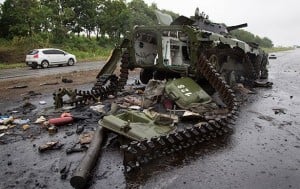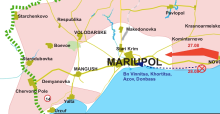Report from Donbass War Theater: Ukraine Government Forces Defeated Prior to “Cease Fire”. Kiev Switches To “Strategic Defense”
Commentary by Michel Chossudovsky

Global Research Editor’s Note
Media disinformation prevails with regard to Donbass.
World public opinion is unaware that prior to the signing of a “cease fire”, Kiev forces had already experienced a devastating defeat, with casualties estimated well in excess of ten thousand. This tragic loss of life has not been reported by the MSM. From both Kiev and US-NATO’s point of view they are “cannon fodder”.
Ukraine government forces have been in retreat. Thousands of soldiers have been killed. Thousands more have refused to fight and have abandoned the battlefield. Soldiers from Ukraine government forces have also sought refuge in Russia. The Donbass rebels have made overtures to Ukraine government soldiers to enable them to leave the war zone.
President Poroshenko accepted the 7 point cease fire agreement on September 5, to enable Ukrainian troops to withdraw rather than surrender.
The following report (original Russian) was prepared by Colonel Cassad LiveJournal, translated by Slavyangrad.org to which we are much indebted.
The Live Journal report confirms that as of September 3, two days before the cease fire agreement, “the fascist Junta had switched to strategic defense in the Donbass.”
Let us be under no illusions: this war is not over. US-NATO is not interested in a peaceful solution. Nor does it favor negotiations between its Kiev puppets and the two Donbass governments, Donetsk and Lugansk. Washington design is to perpetuate the humanitarian disaster in Donbass and create divisions within Ukraine society.
Meanwhile, the IMF economic reforms are contributing to impoverishing the Ukrainian population.
While there are Russian forces under Russian command in Ukraine as confirmed by the OSCE, reports confirm that the Pentagon has dispatched US military advisers to Ukraine who have integrated the ranks of Kiev forces in Eastern Ukraine.
Michel Chossudovsky, Global Research, September 6, 2014
Report from Donbass War Theater. Kiev Switches To “Strategic Defense”
by Colonel Cassad LiveJournal (Russian)
The events of recent days clearly indicate that the Kiev Junta is switching to strategic defense tactic in the Donbass.
 1. The positions around Mariupol, Artemovsk, Constantinovka, and Lisichansk are being fortified. This is no longer about using these cities as bases for an offensive, we are talking about trying to hold them in defensive battles. The Militia should accomplish putting an end to the shelling of Donetsk in about a week. The Junta will try to keep shelling for political reasons; as the cessation of terror attacks on Donetsk would be a clear symptom of a complete disaster, even for the most brainwashed “European Ukrainians”
1. The positions around Mariupol, Artemovsk, Constantinovka, and Lisichansk are being fortified. This is no longer about using these cities as bases for an offensive, we are talking about trying to hold them in defensive battles. The Militia should accomplish putting an end to the shelling of Donetsk in about a week. The Junta will try to keep shelling for political reasons; as the cessation of terror attacks on Donetsk would be a clear symptom of a complete disaster, even for the most brainwashed “European Ukrainians”
 2. Leaving more than 20 settlements in Lugansk People’s Republic(“LPR”) with open flanks shows that attempts encircle the city are over. Junta forces that can be saved, will be pulled out of the boiler to the south-west of Luhansk, then the front will slowly move away to the north of Lugansk, because in its current configuration, Junta is risking enveloping strikes by Novorossiya Armed Forces (“NAF”) mechanized units. A huge column of armored vehicles in Krasnodon demonstrates the potential power of such attacks, against which the Junta simply has nothing.
2. Leaving more than 20 settlements in Lugansk People’s Republic(“LPR”) with open flanks shows that attempts encircle the city are over. Junta forces that can be saved, will be pulled out of the boiler to the south-west of Luhansk, then the front will slowly move away to the north of Lugansk, because in its current configuration, Junta is risking enveloping strikes by Novorossiya Armed Forces (“NAF”) mechanized units. A huge column of armored vehicles in Krasnodon demonstrates the potential power of such attacks, against which the Junta simply has nothing.
3. The Junta is moving troops from Perekop to Mariupol and Odessa. We can now say goodbye to the plans of military provocations by Armyansk and Chongar. The huge losses of the “Crimea” punitive battalion by Ilovaysk have also seriously weakened the potential future reconnaissance and sabotage capacities in Crimea proper. The Junta initially made a fundamental error when it began massing a part of its forces by Perekop. They were not sufficient to capture Crimea, or to fend off a Russian invasion from the Crimea, and it is quite possible that several battalions with reinforcements were exactly what the Junta lacked in the decisive battles for Shahtersk and Krasnyi Luch. In the end, they still had to be redeployed to the Donbass, but only after they could no longer change anything, strategically. The Crimea itself has now been completely taken out of the equation; the Junta now has too much to deal with elsewhere, so the ambitious plans of military and political pressure on the Crimea are apparently dead for now.
4. A similar pattern of events has occurred in the area near Transnistria. The forces that the Junta had concentrated there have now been redeployed to Donbass to close holes in the front lines. The plan of combined pressure against Transnistria, together with the United States and Moldova, turned out to be stillborn. Now there are no chances for a successful offensive there, so nothing serious will be deployed against Transnistria.
5. The Junta’s fourth wave of mobilization is supposed to somehow make up for their losses, but its “success” will be similar to the third wave. The fact that the fresh cannon fodder are being equipped with obsolete BTR-60/70 APCs (Armoured Personnel Carriers) and machine guns from the 1930s clearly indicates that those unfit for service will also be armed with obsolete weapons, so ground down professional army brigades will be replaced with the new “Ukrainian Volkssturm” – pointless and depressing, and even the punitive battalions will appear capable in comparison to these new forces.
6. The Junta persists in the separation of army units from punitive forces. Punitive units are now even given tanks and IFVs, thus repeating the failed experiment of the Nazis, separating individual units of the SS from the rest of the armed forces, with their own hierarchy, equipment and command. The main problem in these units is lack of competent commanders, which systematically results in high losses of personnel and vehicles.
7. Thus, the autumn starts with the Junta in transition from offence to defense, and there are clearly not enough resources to hold the entire line; even after the front is straightened out. It should be understood that even if the Junta could stretch a solid front line from Donetsk to Berdyansk, there would be nothing available to close a gap in the event of another breakthrough. In general, the size of the theater of operations clearly exceeds the abilities of the warring parties. The Junta is facing the same problem faced by the NAF in June, when it was trying to hold large areas without sufficient forces to do so, which led to breaks in the front. Now the Junta is in the same situation, thus emphasizing that operational initiative is the key to victory, in the event one lacks sufficient forces to control large swathes of territory. The side which has the operational initiative can choose the direction of attack, concentrate forces there, achieve local superiority, and convert these efforts to captured towns and cities; and burning enemy vehicles with charred corpses lying along the roads.
8. As the Junta cannot seize the initiative back yet (the concentration of 1-2 brigades by Zaporozhye, to be used for counter-attack, requires a few more days), it began a retreat, during which it tried to free up additional forces for the southern front and transition to a stubborn defense of advantageous positions. It is now key for the NAF to keep the operational initiative, as it more than offsets the advantages of the enemy in manpower and vehicles. In this respect, while carrying out offensives in several directions, it is important not to overdo it and not to expose the flanks to cleaving strikes of Junta’s mechanized forces (the NAF still had trouble parrying these strikes as late as August).
Overall, as of September 3rd, we can confidently say that the fascist Junta has switched to strategic defense in the Donbass.
Translator: Daniil Mihailovich
Editor: S. Naylor
Original Source: Colonel Cassad LiveJournal (Russian)

